Cancer research attracts billions of dollars in funding every year from governments, charities and other institutions. This helps to establish the field as a cornerstone of scientific activity in many countries, especially the United States.
Special focus
Cancer research represents a large slice of overall research output in the Nature Index for many institutions, although this does not always translate to a high Share in this field. This is shown in the chart below, which plots Share against the proportion of an institution’s Nature Index output represented by cancer research for the leading 200 institutions in the topic.

Source: Nature Index. Data analysis by Bo Wu. Infographic by Simon Baker, Bec Crew and Tanner Maxwell
Some outliers are highlighted in the chart below. Specialist cancer centres unsurprisingly have a high proportion of Nature Index output related to cancer research. But two in the United States, the Memorial Sloan Kettering Cancer Center in New York City and University of Texas MD Anderson Cancer Center in Houston, Texas, are clear of other specialist institutions on Share.
The Chinese Academy of Sciences, in Beijing, has a relatively low proportion of Nature Index output focused on cancer research, but it still has the second highest Share for the period 2018–22.
Harvard University in Cambridge, Massachusetts, has the world’s leading Share of cancer research, and more than one-fifth of its total Nature Index output is in this area. The National Institutes of Health, a major funder of cancer research in the United States, also has a high Share. Stanford University in California has a Share of 343, despite just 11% of its overall Nature Index output for the period 2018–22 being related to cancer research.
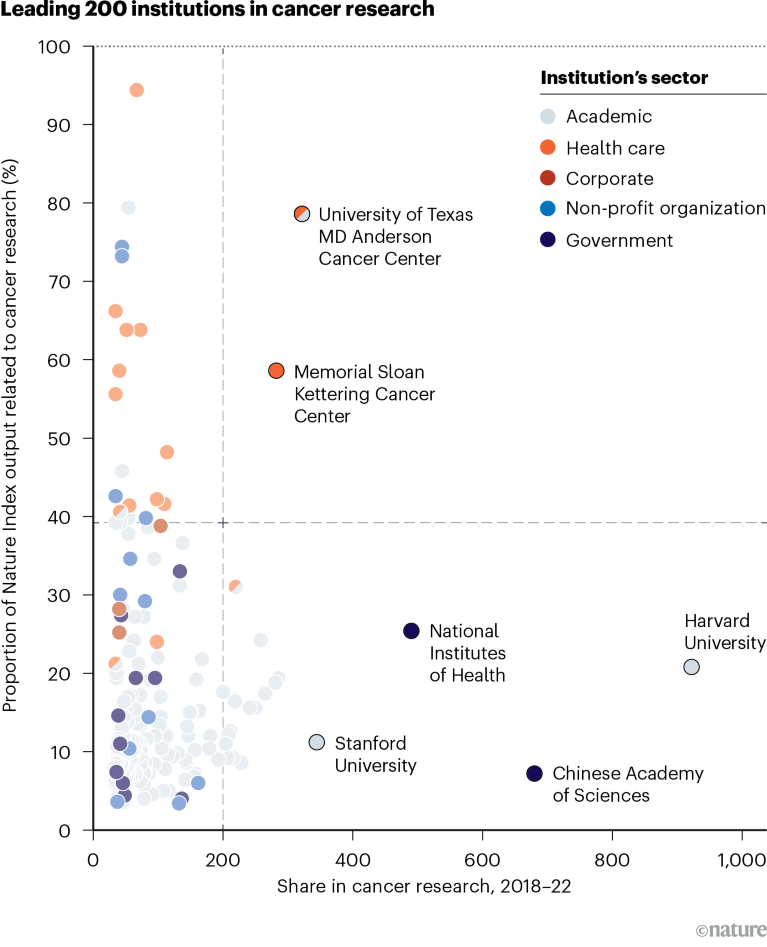
Source: Nature Index. Data analysis by Bo Wu. Infographic by Simon Baker, Bec Crew and Tanner Maxwell
North American giant
With 10,280 grants worth a total of US$13.1 billion awarded in 2018–22, the US National Cancer Institute (NCI) dwarfs all other major North American funders of cancer research. Among the 27 institutes and centres of the US National Institutes of Health, the NCI is the largest, with a federally allocated budget of $7.3 billion for 2023, up $408 million on last year.
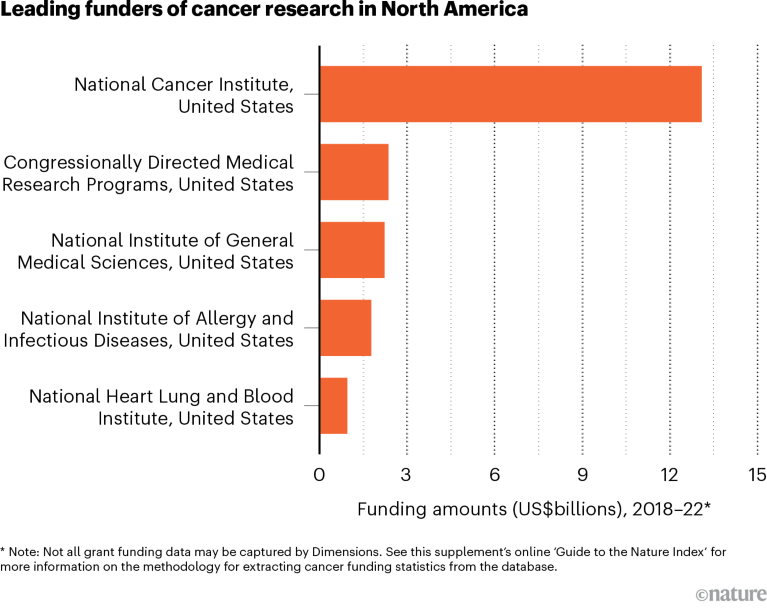
Source: Dimensions. Data analysis by Bo Wu. Infographic by Simon Baker, Bec Crew and Tanner Maxwell
Europe’s key spenders
The European Commission, which invests in science through the European Union’s ‘Horizon’ funding programmes, allocated almost 1,300 cancer research grants from 2018 to 2022, totalling $2.5 billion, according to Dimensions data. The European Research Council, another beneficiary of Horizon money, funded grants worth around $850 million.
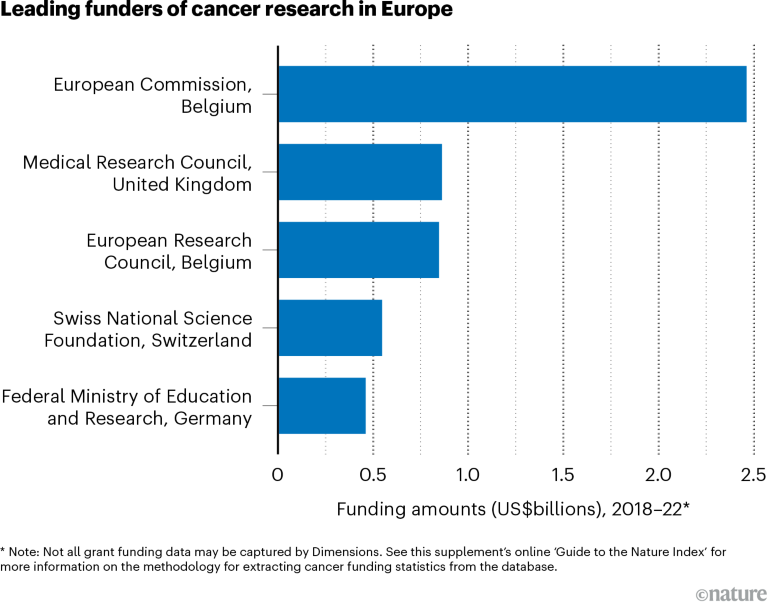
Source: Dimensions. Data analysis by Bo Wu. Infographic by Simon Baker, Bec Crew and Tanner Maxwell
Asia-Pacific spread
The Japan Society for the Promotion of Science allocated the most money for cancer research from 2018 to 2022 among Asia-Pacific funders listed in the Dimensions database. Its 15,665 grants were worth a total of around $860 million. The National Natural Science Foundation of China was close behind, distributing 11,910 grants worth about $810 million.
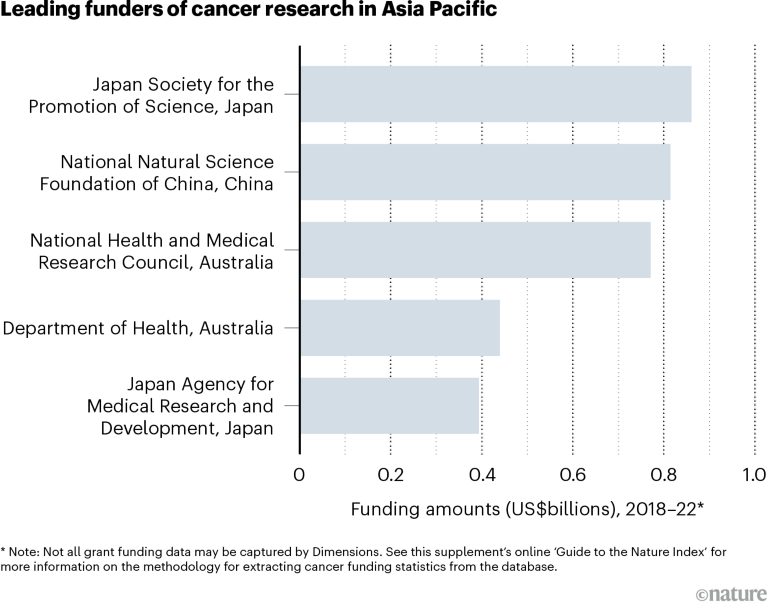
Source: Dimensions. Data analysis by Bo Wu. Infographic by Simon Baker, Bec Crew and Tanner Maxwell
Lost connections
The United States is a force in international cancer research: it helps form the five leading bilateral country collaborations in the Nature Index for 2018–22. The United States and China had the most prolific partnership by some margin. But a steep decline since 2018, probably reflecting the impact of rising political tensions and the COVID-19 pandemic, has hugely reduced the gap with other US partnerships.
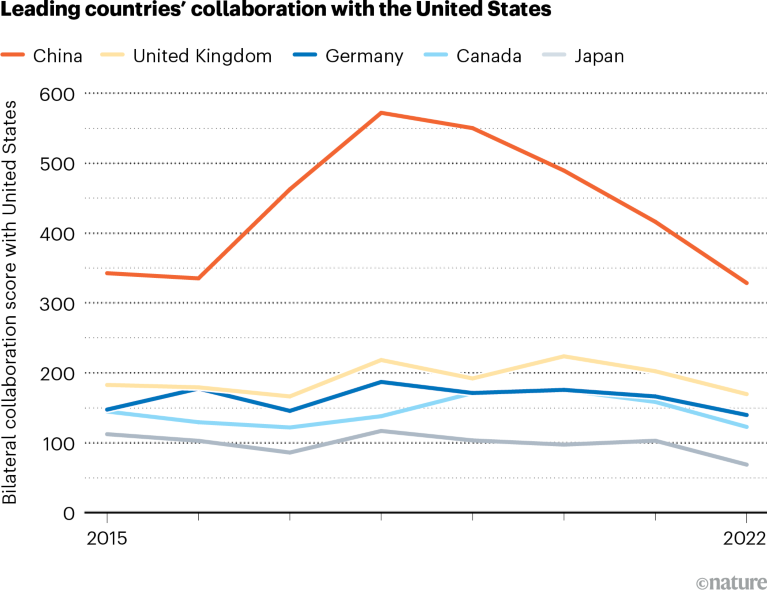
Source: Nature Index. Data analysis by Bo Wu. Infographic by Simon Baker, Bec Crew and Tanner Maxwell
Prolific partners
The leading five institutional pairs in cancer-related research for 2018–22 are all domestic partnerships. A rapid growth in collaborative articles between the University of Chinese Academy of Sciences and the Chinese Academy of Sciences since 2016 is the most striking trend.

Source: Nature Index. Data analysis by Bo Wu. Infographic by Simon Baker, Bec Crew and Tanner Maxwell

 Can cancer research shift its focus?
Can cancer research shift its focus?
 Ukraine seeks to resume its role in cancer clinical trials
Ukraine seeks to resume its role in cancer clinical trials
 Four ways research aims to outwit cancer’s evasion tactics
Four ways research aims to outwit cancer’s evasion tactics
 The gross imbalances of cancer research must be addressed
The gross imbalances of cancer research must be addressed
 African scientists call for research equity as a cancer crisis looms
African scientists call for research equity as a cancer crisis looms







